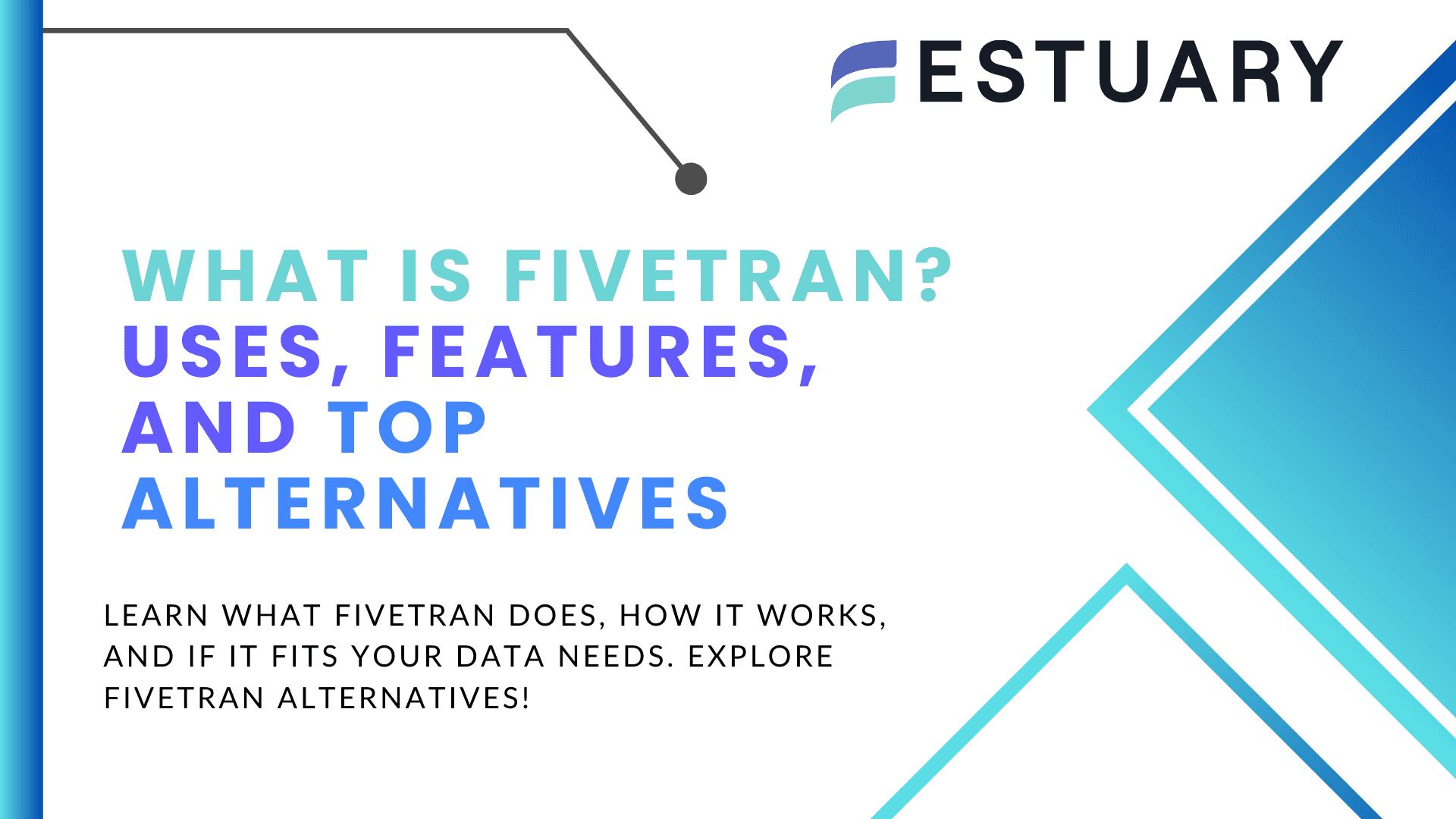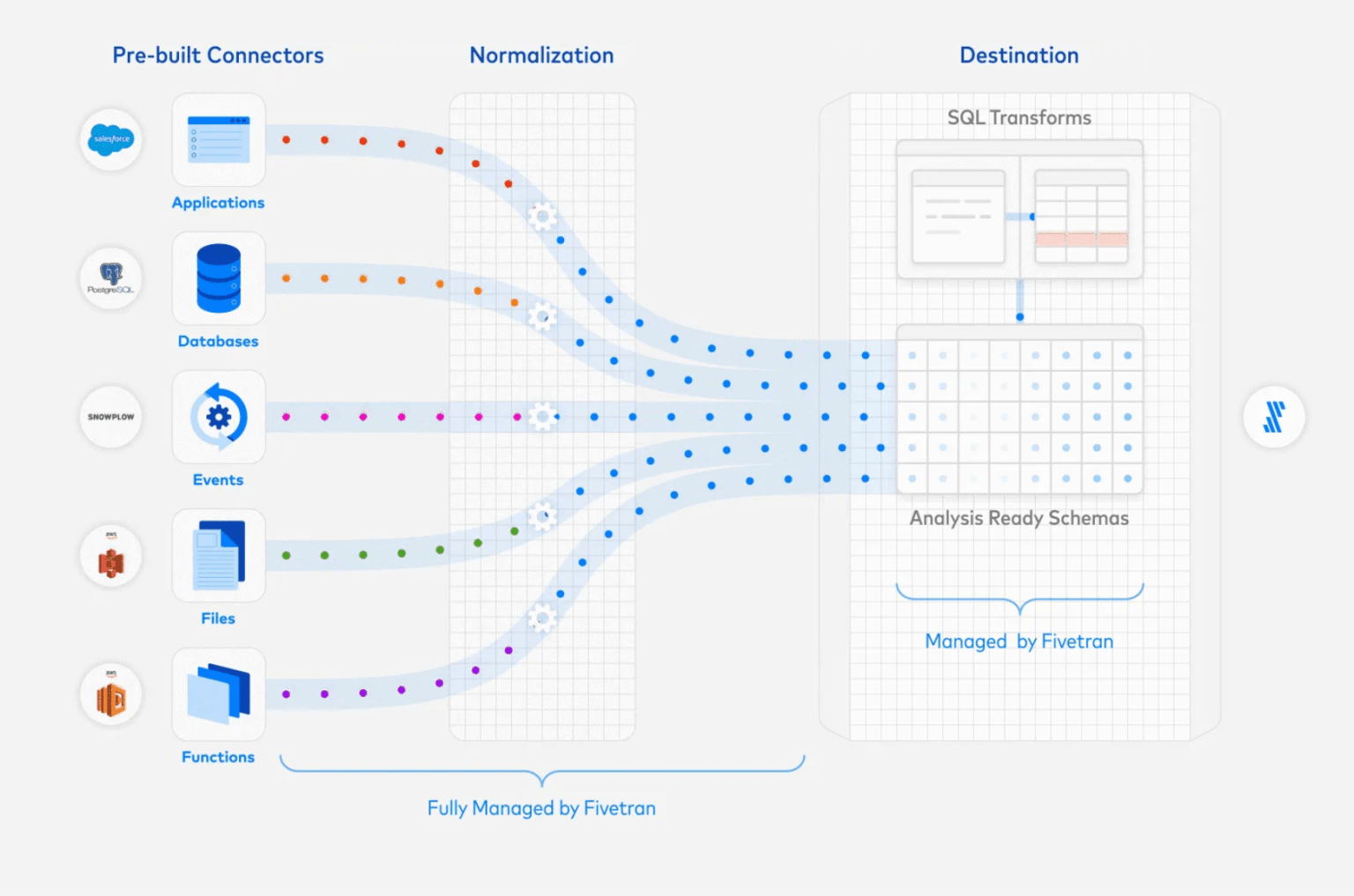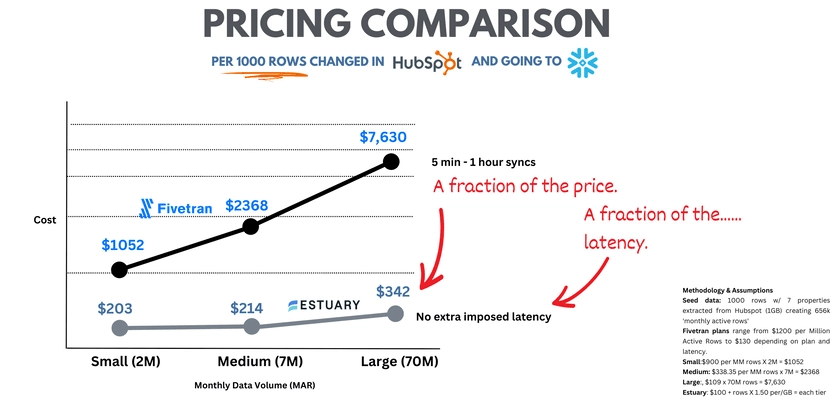
Understanding Fivetran: The Basics
Fivetran is a cloud-based data integration platform that extracts, loads, and transforms (ELT) data from various sources into data warehouses. Its primary goal is to simplify and streamline data pipelines, allowing businesses to focus on analysis rather than complex data engineering tasks.
This Fivetran review guide explores how it’s used, its core features, and compares it to the alternatives.
What is Fivetran Used For?
Fivetran serves one main purpose in the modern data stack: to load data into a data warehouse.
- Data Consolidation: Fivetran is primarily used to gather data from various sources into a cloud data warehouse.
- Automated ETL/ELT: Organizations use Fivetran to automate the extract, load, and transform process, reducing the need for manual data engineering work.
- Real-time Data Syncing: Fivetran is not as fast as some alternatives. It is a batch-based system, with most deployments typically extracting and loading data in intervals ranging from tens of minutes to hours.
- Data Warehouses Supported: Fivetran is commonly used to populate data warehouses like Snowflake, Google BigQuery, or Amazon Redshift with data from various sources.
- Analytics Preparation: Fivetran replicates data to a data warehouse and relies on dbt to transform and prepare data for analytics.
- SaaS Data Integration: It's particularly useful for integrating data from multiple SaaS applications.
- Database replication: Fivetran can replicate data from databases using change data capture (CDC), though it only does it in batch intervals, not in real-time.
How Fivetran Works
At its core, Fivetran employs an ELT approach:
- Extract: Fivetran connects to your data sources and extracts the relevant information.
- Load: The extracted data is then loaded into your chosen destination, typically a cloud data warehouse.
- Transform: Once loaded, data can be transformed within the destination using SQL or tools like dbt.
This process is largely automated, with Fivetran handling schema inference and evolution, data type mapping, and incremental updates without requiring manual intervention.
Fivetran Connectors: Bridging Data Sources
One of Fivetran's key strengths lies in its extensive library of pre-built connectors. These connectors support a wide array of data sources, including:
- SaaS applications (e.g., Salesforce, Zendesk)
- Databases (e.g., MySQL, PostgreSQL)
- Analytics platforms (e.g., Google Analytics, Adobe Analytics)
- File storage systems (e.g., Amazon S3, Google Cloud Storage)
Fivetran’s list of nearly 300 native connectors and 300+ lite connectors that invoke APIs allows businesses to quickly integrate data from multiple sources without having to develop custom integrations.
Fivetran Pricing: Understanding the Cost
Fivetran's pricing model is based on Monthly Active Rows (MAR), which represents the number of rows synced from your data sources each month. While this can be advantageous for smaller data volumes, it may lead to unpredictable costs. MARs are based on Fivetran’s internal highly normalized representation of data, not the source representation. This can make some connectors, especially non-relational sources, very expensive. There are also connectors that require you to extract all data.
Fivetran offers different tiers with varying features and support levels, allowing businesses to choose a plan that aligns with their needs and budget.
Fivetran and dbt: A Powerful Combination
Fivetran's integration with dbt (data build tool) is what provides its data transformation capabilities. It allows users to define, test, and document data transformations using SQL, promoting collaboration between data engineers and analysts.
Fivetran vs. Other ETL Tools
While Fivetran has established itself as a leader in the ELT data integration space, it's crucial to consider Fivetran alternatives that might better suit specific business needs. Let's compare Fivetran to three notable ELT and ETL competitors: Stitch, Airbyte, and Estuary.
a) Fivetran vs. Stitch
Stitch, acquired by Talend which was in turn acquired by Qlik, offers a similar ELT approach but with a smaller connector library. It may be more cost-effective for smaller data volumes but lacks some of Fivetran's advanced features. Stitch was built on the open source Singer framework, which is no longer as actively maintained since the Stitch acquisition. While there are other vendors like Meltano using Singer, the lack of maintenance is cited as a concern.
Learn a detailed comparison: Fivetran vs Stitch
b) Fivetran vs. Airbyte
Airbyte distinguishes itself by embracing an open-source model, which empowers users to collaboratively create and enhance data connectors, fostering a dynamic ecosystem of integrations. While it offers greater flexibility, implementing the open source requires technical expertise to implement and maintain compared to Fivetran. Airbyte Cloud is a more suitable comparison. It is definitely one to compare.
Airbyte started as a Singer-based ELT tool, but has since changed their protocol and connectors to be different. Airbyte has kept Singer compatibility so that it can support Singer taps as needed. Airbyte has also kept many of the same principles, including being batch-based. This is eventually where Airbyte’s limitations come from as well.
Airbyte has become one of the main alternatives to consider when replacing Fivetran if you’re concerned about cost or are considering self-hosted open source. While its latency in open source is comparable to Fivetran, Airbyte Cloud latency is only 1+ hours. It does not always provide exactly-once guaranteed delivery, which requires deduplication at the destination. It also has more scalability limitations than Fivetran.
Learn detailed comparison: Fivetran vs Airbyte
c) Fivetran vs. Estuary: The Emerging Challenger
Estuary is rapidly gaining attention as a formidable Fivetran alternative, offering several compelling advantages:
- Real-time processing: Estuary boasts sub-100ms latency, making it a great real-time option vs Fivetran’s batch architecture.
- Pricing transparency: Estuary's usage-based pricing model ($0.50/GB + $0.14/hour) provides more predictable costs compared to Fivetran's MAR-based pricing.
- Deployment flexibility: Estuary offers public cloud, private cloud, and open-source self-hosting. While Fivetran offers a private cloud option with 5 source database and 4 data warehouse connectors as well as self-hosted HVR, its public cloud option is really the only complete ELT offering.
- Multi-use case support: Fivetran is great for loading a cloud data warehouse, but that’s about it. Estuary supports many more use cases that require real-time or ETL including replication, operational analytics, data science and ML, and generative AI.
- Support for multiple destinations: Estuary can support multiple destinations across use cases with a single pipeline. Fivetran can only support one destination with each data pipeline.
- Backfilling and time travel: Estuary stores data as it streams and lets you backfill destinations at any time, reprocess data, or use time travel without having to re-extract from each source.
For organizations prioritizing real-time data processing, cost predictability, and advanced integration features, Estuary emerges as the superior Fivetran alternative.
Read detailed comparison: Fivetran vs Estuary
Looking for more Fivetran Alternatives? Read here.
Security and Compliance
Fivetran takes data security seriously, implementing robust measures to protect sensitive information. The platform is SOC 2 Type II compliant and adheres to GDPR regulations. However, it's essential to review Fivetran's security practices and ensure they align with your organization's specific compliance requirements.
Getting Started with Fivetran
Implementing Fivetran involves a few key steps:
1. Sign up for an account and choose a pricing plan.
2. Set up your data warehouse destination.
3. Configure your data sources using Fivetran's connectors.
4. Define and schedule your data syncs.
5. Monitor and manage your data pipelines through Fivetran's dashboard.
While the process is relatively straightforward, larger organizations may benefit from Fivetran's professional services for more complex implementations.
Conclusion: Is Fivetran Right for You?
Fivetran provides a comprehensive ELT platform for companies loading a cloud data warehouse. Its extensive list of connectors, automated pipeline management, and integration with dbt make it an attractive option for many organizations.
However, as your data integration needs expand beyond the cloud data warehouse,, alternatives like Estuary are a better option. When choosing a data integration tool, carefully consider your specific needs, budget constraints, and future use cases.
Ultimately, the right choice depends on your organization's needs. Whether you opt for Fivetran or explore newer alternatives like Estuary, make sure to map out what your organization needs today, and in the future.
FAQs
1. Is Fivetran an ETL or ELT tool?
Fivetran is an ELT tool. It extracts data from sources, loads it into a data warehouse, and then transforms it within the warehouse using tools like dbt.
2. What are the limitations of Fivetran?
While powerful, Fivetran has limitations:
- Batch-based processing: Not ideal for real-time data needs.
- Unpredictable costs: MAR-based pricing can be expensive for large datasets.
- Limited transformation capabilities: Complex transformations might require additional tools.
3. When should I consider using Estuary over Fivetran?
- Real-time data processing (Estuary offers sub-second latency).
- Predictable costs: Estuary uses usage-based pricing.
- More flexibility: Estuary supports multiple destinations and use cases.
4. Does Fivetran offer a free trial?
Yes, Fivetran offers a free trial with limited features to test the platform.

About the author
Rob has worked extensively in marketing and product marketing on database, data integration, API management, and application integration technologies at WS02, Firebolt, Imply, GridGain, Axway, Informatica, and TIBCO.
Popular Articles











